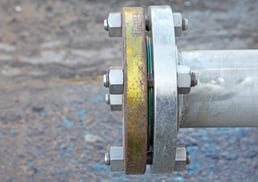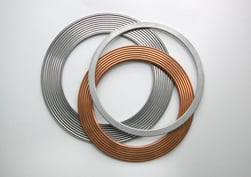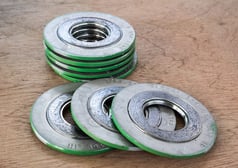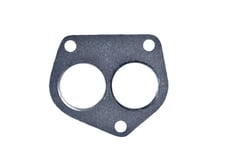When something works well, you likely won’t even notice. In manufacturing, well-running machines result from precise engineering using the right components to provide a smooth, dependable, and quiet experience.
Searching for suitable gasket material will leave you with many options, but how do you know when you’ve found one that can meet the proper tolerances for an accurate fit?
At Strouse, we’ve had many clients approach us about figuring out which material suits their gasket. The key is to consider your different options and test certain materials based on their favorable properties for your project.
Before you engineer your next flexible material project, read our overview of gasket materials to see what might function as a potential solution.
Defining Gaskets
At its core, a gasket prevents matter from passing from one place to another, be it a liquid, gas, or energy discharge. Whether you need something to last a long time, resist pressure and high temperatures, or avoid conducting electromagnetic resonance, a gasket exists to meet that need.
While the purpose of any gasket is to maintain a seal between two elements, a variety of shapes and types of gaskets are employed depending on the situation.
What Are the Most Common Types of Gaskets?
The type of gasket you use depends on many different factors, including your application, substrates, and the intended length of use.
 PIPE GASKETS
PIPE GASKETS
Simple joints, like those found in pipes, use pipe gaskets. These are circular and usually require a higher tolerance for compression. A pipe gasket must also resist corrosion and extreme temperatures to maintain its shape over time.
A combination of metallic, non-metallic, and composite materials ensures that each joint remains sealed. As versatile as they are, pipe gaskets aren't a one-solution-fits-all endeavor, so you’ll still need to ensure appropriate measurements and materials.
 JACKETED GASKETS
JACKETED GASKETS
The most employable of gaskets is the jacketed type. Jacketed gaskets provide flexibility from a soft core and resilience with an external coating.
With jacketing, one surface of a gasket may be covered with a metal material on both sides. A product is referred to as “double-jacketed” when both sides are wrapped around a softer core. Double-jacketed gaskets provide better corrosion resistance over single-jacketed gaskets, as there is less possibility of material seeping into the core.
Another type of jacketed gasket is the corrugated jacketed gasket, which interweaves materials in layers, making for specialized combinations of flexibility and durability.
 SPIRAL WOUND GASKETS
SPIRAL WOUND GASKETS
Like a jacketed gasket, spiral wound gaskets seek to combine the best of both worlds. These use a combination of metals and plastics (or rubber) wound around metal layers.
The resulting gasket yields acute physical resistance to stress and high heat. The gasket remains rubbery, so it seals well in moving joints and where fluids, gasses, or heat exchange is needed.
KAMMPROFILE GASKETS
Kammprofile gaskets can be thought of as a jacketed spiral wound gasket. A corrugated metal core is covered in a sealing material on both sides with this type of gasket.
The kammprofile gasket uses physic stress to focus tension onto the surface sealant to form a seal. This process leverages the different core materials to the sealing material to effectively reduce stress and transfer heat without further deformation.
 SOLID GASKETS
SOLID GASKETS
Solid gaskets are metal gaskets that are inexpensive and easy to use. They are used in high-thermal and high-pressure situations and require immense compression force to form a seal properly.
Solid gaskets are most commonly used between two other dense surfaces that are harder than the gasket material, and the majority of solid gaskets are formed from metals.
Gasketing Tape and Adhesive
Gasketing tape (pressure-sensitive tape made from polymers and metals) can be applied in these situations. The material expands to create a seal and deforms to allow the seal to break with mechanical motion. The result? Reducing noise and containing fluids, gasses, and heat while remaining flexible through weathering and impact.
Thread seal tape (also known as Teflon or PTFE tape) fills in gaps to create a tighter seal while also reducing the friction that can develop locks that split or break the threads from vibrations or percussive force. However, not all gaskets fit into a contained system.
Doors and windows must retain tight seals when closed while allowing people to open them freely. Threads and other locking components may need gasketing tape to reinforce mechanical seals and reduce friction that creates unconformities.
Foam Gaskets
Foam gaskets are another option for applying seals to materials, particularly irregular shapes, or covering large surface areas. In some cases, foam is used much like tape, where a backing layer is attached to one surface, and the foam is uncovered from a surface protection film before the seal is completed.
A few of the foams on this list are foam rubbers, meaning you could also classify them as rubber, but before we go further into that, let’s inspect the foams.
GASKETING FOAM
Gasketing foam can refer to a lot of different types of materials. You can spray foam to apply the maximum amount of material into a gap between two other materials. Foam gaskets applied via spraying do well for noise and impact reduction projects. The seals are less tight than those created by other gasket types, and the material is far less dense.
The Heating, Ventilation, and Air Conditioning (HVAC) industries use foam gaskets to reduce heat exchange between components or provide extra seals on vents. These gaskets will slow fluid (like refrigerant) and gas leaks, albeit not prevent them altogether.
Though foam may lack some durability, the ease of reapplication makes up for it. Foam gaskets work well when other components need frequent repair or replacement.
SILICONE GASKETING
Silicone gaskets are high-performance gaskets that withstand aging and weathering well. Their high elasticity makes them great for troublesome angles. That said, if you need a seal against solvents, fuels, or silicone-based fluids, silicone seals or gaskets will degrade quickly.
Silicone materials are created from silica sands and can be used at a wide range of temperatures, from 400˚F to -67˚F.
NEOPRENE GASKETING
Neoprene is a synthetic polymer rubber. It provides high tensile strength for areas that often move, even under stress, as a gasket material.
Neoprene gasketing works in a temperature range of 230˚F to -40˚F. While this is a smaller range than silicone, neoprene is still usable in a wide variety of environments. As a rubber polymer, neoprene does well with compression but isn't as tough as some other materials.
Neoprene ages well and won't crack or bleach under sunlight. It resists oils, including grease and silicone oil. The polymer's tight pores are excellent at resisting damage from gasses such as refrigerants, carbon dioxide, and ammonia. While there may not be particular weaknesses to pinpoint, neoprene is a middle-of-the-road option for many of its benefits.
EPDM GASKETING
Ethylene propylene diene monomer, or EPDM, is another synthetic rubber polymer with various resistances. It is made from polyethylene and propylene and has a crystallinity that gives it elastic properties.
EPDM gaskets offer excellent resistance against oxygenation, weathering, ozone, and heat; plus, they make excellent electrical insulators. Their operational temperature range is 250˚F to -40˚F, but EPDM doesn't do well with petroleum fluids or oils, which you’ll need to keep in mind.
Rubber Gaskets
Rubber gaskets are a robust sealing solution intended for high-pressure applications. They are resistant to wear and tear but less conformable than foam gaskets.
As previously mentioned, certain foams (such as silicone, neoprene, or EPDM synthetic) are technically also considered rubber, meaning they also possess the typical qualities of rubber with advanced cushioning and damping abilities.
BUTYL
Butyl rubber polymer combines isoprene and isobutylene. Butyl rubber gaskets provide low moisture and gas permeability and protect against aging, abrasion, weathering, and ozone.
The material operates well at temperatures between 248˚F and -67˚F and is an excellent electrical isolator. While it works well against hydraulic fluid, it is not recommended for contact with petroleum fluids.
NITRILE
Nitrile (NBR, Buna-N) is the go-to for petroleum oils and gasoline. It resists other acids, bases, and especially aliphatic hydrocarbons. The nitrile polymer has a lower temperature tolerance than many options, ranging between 212˚F and -40˚F.
Nitrile gaskets offer high compression resistance against permanent compression but have low reformation properties and do poorly against weathering, ozone, and sunlight.
SBR
If you need a natural rubber feel with enhanced characteristics, styrene-butadiene rubber (SBR or Buna-S) is the way to go. SBR gaskets provide better water resistance but still lack solvent or chemical resistance. SBR ages well and performs well in high-temperature applications, ranging from 158˚F to -67˚F. In excessive heat, however, it can harden and become brittle.
NATURAL RUBBER
Natural rubber is difficult to come by and has mild performance. Its best characteristics are its high tensile strength and tear resistance. Plus, it's hard to beat the water resistance it provides.
Natural rubber operates between 122˚F and -67˚F, which can be helpful in some moderate or lower temperature conditions. While it offers certain benefits, it generally doesn’t age or heat as well as polymers and synthetic rubbers.
Additional Gasketing Materials
Some gasketing materials aren’t considered tape, foam, or rubber, so we’ve listed them here.
GORE-TEX GASKETING
Like Teflon, Gore-Tex is a name-brand ePTFE (expanded polytetrafluoroethylene) material. It has many of the same properties as PTFE but expands to provide better flexibility. Gore-Tex ePTFE is used where stability is critical since it avoids intrusions and flaring.
This gasketing material operates at the same temperature ranges as standard PTFE—500˚F to -328˚F—and it’s strong against corrosion and solvents. You’ll want to consider this material's notable weakness: its trouble with exposure to alkali metals and elemental fluorine.
TEFLON (PTFE) GASKETING
Teflon is technically a brand name, but it’s a common shorthand for polytetrafluoroethylene or PTFE. PTFE provides extreme resistance to corrosion, as its tight surface restricts the ripping and tearing of bonds.
PTFE gaskets also provide remarkable temperature resistance ranging from 500˚F to -328˚F. The material is non-flammable and weathers exceptionally well. The low coefficient of friction and lack of adhesivity may be helpful or an obstacle, depending on how you’ll need it.
PTFE does have a perceived drawback when used in water transportation and food devices. Older production runs of PTFE utilize PFOA (perfluorooctanoic acid), which releases a toxic gas at high temperatures. Current PTFE manufacturing, however, uses alternative chemicals to avoid this problem.
GRAPHITE GASKETS
Graphite is another robust and non-porous material that works well for gaskets. Graphite gaskets provide excellent compression characteristics and transfer performance and offer a substantial temperature range of 875˚F to -400˚F. The lattice structure and density of graphite make it ideal for reducing danger from gasses and particulates.
Nuclear-grade graphite slows reactions in reactors. When made into gasket material, it is combined with polymers and metal cores to provide flexibility and reduce brittleness.
Graphite can be interwoven with many secondary materials to create the desired product. These include wire mesh, steel foil, tin-plated carbon steel, and stainless steel foil.
COMPRESSED ASBESTOS-FREE GASKETING
Compressed asbestos-free material is a synthetic fiber composed of elastomeric binders and fillers. The fibers making up these gaskets may be bound using rubber. This material creates high heat resistance and long-term sealability, with a safe temperature range of 400˚F to -40˚F and an operation spike survivability of 700˚F.
Compressed asbestos-free gaskets are well-suited to water, hydrocarbons, and inert gasses and make a solid general-purpose material. However, compared to other materials, they excel only in temperature resistance
Using the Right Gasket Material and Tolerances
With so many gasket materials available, the best results and cost-effectiveness can only be expected when you use the right one. However, this will require testing and prototyping, so you’ll want to enlist the help of an experienced converter to guide your selection process.
Using our rapid prototyping sampling department, Strouse helps customers prove out their designs. We also offer trials for larger quantities or products with additional FDA requirements (such as medical gaskets).
Having the right gasketing materials is only a part of the process— what’s your manufacturing plan? An experienced gasket manufacturer and converter like Strouse will help you bring your product from conception to completion.
Contact us for a flexible material consultation or visit our Learning Center to determine the best production options for your unique design.
Originally published: June 24, 2020
.jpeg?width=290&name=0%20(1).jpeg)






